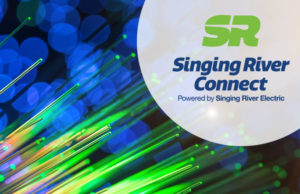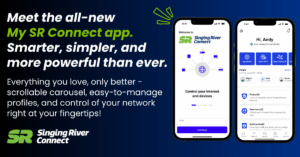How is fiber internet different from other options?
January 18, 2022

Internet technology has advanced exponentially over the past three decades. Faster and more reliable than ever, today’s consumer has more choices when it comes to high-speed internet.
But if your neighborhood has a variety of options, which kind of internet technology should you choose? Is there any real difference between the different internet services available? And what exactly are these technologies anyway? And how do they work?
At Singing River Connect, we hear these questions all the time and understand how confusing it can be.
We present this primer to explain key terms and technology to help inform you so you can make better choices about internet service.
What is Coax Cable Internet?
Coax cable, short for coaxial cable, is the same technology used to provide cable television. It is composed of an insulated copper core of wires, which can carry both internet and television signals simultaneously.
As an asymmetric technology, cable’s primary disadvantage is its markedly slower downloading speed. But, for the typical family and business user, cable’s downloading speed is probably sufficient. Cable has been a common technology for decades, and many businesses and residential customers use it, especially since it can also provide television service.
What is Fiber Broadband Internet?
Fiber optic internet uses cables containing extremely thin, hair-width, glass-like strings of fiber material. Unlike coax cable, fiber optic technology converts internet data in the electrical signals into light and then transports that converted light at extremely fast speeds into your modem and home. Because fiber optic technology transforms data into light, it is much faster than coax cable internet.
Fiber optic internet can sometimes be more expensive than coax cable because the infrastructure isn’t available everywhere yet. Establishing fiber optic internet service and connecting it to your home or business can carry higher upfront costs than coax cable, which is prominent in most residential areas.
And what is Wireless Internet?
Wireless Internet is provided through the air rather than through wires or cables installed and connected to your home or building. Transmitted through a Point of Presence such as a transmitter radio—like on a cell phone tower—it doesn’t rely on substantial amounts of physical infrastructure like cable and fiber optic internet.
Wireless Internet is also fixed—the data transmitted to your home or business does not vary from the data plan with which you contract. If you choose a 25MBs per second speed plan, that is the speed your internet will be delivered. If you choose a 1GB per second speed plan (the fastest speed Wireless Internet currently offers), that’s what you’ll receive. But keep in that it is more expensive than coax cable as well.
More common in rural areas (where there is less of a broadband infrastructure grid), Wireless Internet is provided by 3G and 4G cellular data service providers, such as cell phone service companies, as well as via satellite and dishes.
And don’t confuse “Wireless Internet Service” with “Wi-Fi!” They’re commonly confused, and the names are easily interchanged with one another. Remember that Wi-Fi refers to the router-based wireless system in your house or business—internet enters your home through the modem and is transmitted through a Wi-Fi router to all of your Wi-Fi-capable devices. Wireless Internet, on the other hand, is another form of internet service, like fiber optic or coax cable service.
So which is best? Fiber or Cable or Wireless?
Call us biased, but Fiber Optic Cable is hands-down the fastest, most reliable, and highest quality internet service technology available on the market today. The maximum transfer rates of fiber internet are higher than any other service available.
Fiber infrastructure is newer than cable or most Wireless infrastructure, and that improves performance and reliability.
So be sure to do your homework. Research and ask questions. Singing River Connect’s helpful and knowledgeable team will assist you with questions related to our fiber-to-the-home service.



